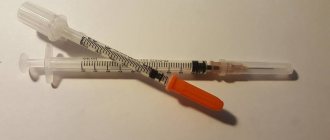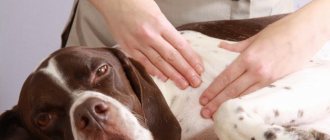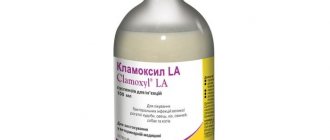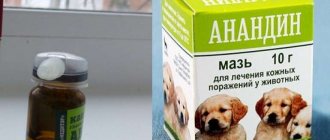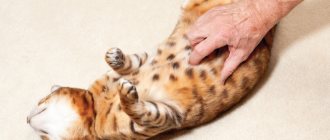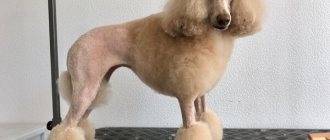Maria Alexandrovna Began
veterinarian Petstory
In this article we will look in detail at how to give a cat an intramuscular injection; this skill may be needed by all animal owners. It is important to remember that medications, dosages and methods of administration (subcutaneous or intramuscular) must be prescribed by a veterinarian. Not all medications can be self-administered without the assistance of a specialist. Before you give your cat an injection, you need to know exactly how and where to inject correctly.
- Intramuscular injection for a kitten
In what places can the injection be given?
For both people and animals, injections are placed under the skin, into a vein, muscle, joint, or intra-abdominal space.
Intravenous, intra-articular, intra-abdominal injections can only be done by a specialist (in extreme circumstances, you can see how this is done in a clinic, ask about the features of the technique and try it yourself under the supervision of a doctor). And any owner can master the technique of injecting medication intramuscularly and subcutaneously. The cat should be given an injection only in areas whose anatomical features make it possible to achieve the greatest therapeutic effect. For intramuscular injections: the back of the shoulder and thigh muscles, subcutaneous - the fold between the shoulder blades at the withers, the fold between the torso and the front of the thigh. Which method to choose and where to administer the medicine depends on the chosen drug.
How to choose the right syringe
The syringe is also selected depending on the drug - its volume and injection site. For injection into the muscle, instruments with a volume of 1-10 ml are suitable. If the amount of medicine is large enough, for smooth administration you should purchase a syringe with a piston equipped with a special seal. For a small volume of injection solution (up to 1 ml), an insulin syringe with convenient graduation is used.
It is advisable that the needle used to administer the drug intramuscularly is not too long. The femoral and brachial muscles of cats (especially kittens) are small, which increases the risk of damage to the sciatic nerve or bone. An insulin syringe equipped with a thin and short needle will also help out here. An injection into muscle tissue is more painful than under the skin, and a thin, sharp needle will slightly reduce pain.
Subcutaneous injections are tolerated more easily by animals - there are not too many nerve receptors in the withers. Needles can be longer and thicker, and syringes of different sizes, depending on the indications. Typically, the amount of medication injected into the subcutaneous space is greater than into the muscle.
When selecting an instrument for giving injections to a cat, take into account the consistency of the drug. Oil solutions are distinguished by viscosity, ductility and require larger diameter needles.
Preparing for the injection
Before you give your cat an injection, you need to prepare everything you need.
- Determine the location where the procedure will be performed. It should be smooth, not slippery, preferably at the level of a regular table.
- Before taking the medicine, you should make sure that the drug is not expired. It will not be superfluous to re-read the instructions for the medicine, as well as the veterinarian’s prescription for time and dosage.
- The cold preparation must be warmed up to body temperature (it is enough to hold it in your hand for a while).
- To draw the medicine from the ampoule, its upper narrow part is broken, first wrapped with a piece of cotton wool.
- The powder form of the product must be diluted with saline, novocaine or a special solution included in the kit (check with your veterinarian for details on dosage). First, the solution is drawn into the syringe, then it is injected into a vial of powder, the medicine is dissolved with light circular movements (without shaking), and then drawn back into the syringe. After this, it is advisable to change the needle.
- When the medicine is drawn up, you should get rid of air bubbles - lift the syringe with the needle up, lightly tap the cylinder, ensuring that the bubbles accumulate under the medicine outlet, press slightly on the piston until the air comes out and drops of the drug appear.
Unneeded cotton wool, ampoules and other items should be disposed of, and the prepared syringe can be briefly placed on a clean surface (plate, container), covering the needle with a cap.
How to give an injection in the thigh
An intramuscular injection into a cat is given into the thickness of the femoral or brachial muscle. Before making an injection, it is necessary to palpate the muscle, determine the injection site, and make sure that the animal is calm and the muscle tissue is relaxed. For relaxation, you can pre-massage the limb.
The angle of insertion of the needle into the thigh should be approximately 90˚, the penetration depth should be no more than a centimeter. It is necessary to ensure that the needle does not completely enter the muscle - there should be a gap between the surface of the body and the plastic.
As soon as the needle is in the muscle tissue, you need to calmly press the plunger and slowly inject the medicine. You cannot move, turn, or deepen the syringe while giving an injection. Remove it in the opposite direction, with a quick movement.
The procedure is ongoing
Without a doubt, the injection is unpleasant for animals and causes them considerable discomfort. Unfortunately, situations may arise when the injection must be given continuously over a certain period of time. In this case, it is worth taking care of maximum comfort for the pet in order to avoid prolonged stress.
It will not be possible to train your pet to endure pain, but there is an opportunity for associative perception:
- Injections into the cat's thigh should be done at the same hours and in the same environment.
- The pet must be in a calm state of mind.
- Immediately before the procedure, you should begin to establish contact with the animal: stroke it, caress it.
- After the injection, be sure to praise your pet and give him his favorite treat.
Following these recommendations will help the animal endure discomfort more patiently and be calmer.
How to give a subcutaneous injection
It is easier to inject a cat under the skin than in the thigh. Firstly, the withers are considered less sensitive to mechanical influences (it’s not for nothing that cats drag their cubs by the withers), so this place is ideal for administering painful solutions. Secondly, much larger volumes of medicinal solutions (up to 70-90 ml) can be injected subcutaneously than into the femoral part. Thirdly, there is no risk of the needle getting into a bone, joint or nerve, as happens with intramuscular injection. The only point that needs to be paid special attention to is that the skin here is thicker than the thigh, so you need to apply force to pierce it.
The injection technique under the skin is as follows:
- With one hand, the skin in the withers area needs to be gathered into a fold;
- with the other hand, under the skin pulled upward closer to the body, with some effort, insert the needle at an angle of 45˚ relative to the surface of the body;
- administer a medicinal product;
- remove the syringe;
- release the skin.
It is advisable that someone from the side during the procedure slightly press down the head and back of the pet’s spine.
Important! If you have no experience in administering medication subcutaneously to your cat, there is a risk of piercing the skin through. This probability is due precisely to the thickness of the skin and its resistance during piercing with a needle. Therefore, during the injection process, you need to pay attention to the opposite side of the fold - if droplets appear on it, you need to pull the needle a little towards yourself, and then continue the procedure.
Why the back paw?
Often, beginning cat breeders do not understand why it is preferable to choose the hind limb for injections.
In fact, this choice is quite justified due to objective reasons:
- The most important reason is the abundance and thickness of muscle tissue. A normally well-fed pet has a real “ham” on its hind leg, which allows the needle to be inserted deep enough without injuring the surrounding tissue or scratching the bone. But this, again, only applies to animals with normal fat and in good physical shape. In addition, during the injection it is much more convenient to fix a normally developed muscle with your fingers.
- The gluteal and thigh muscles have a good blood supply and contract strongly when walking or running. All this contributes to the rapid and complete absorption of the drug from the site of its administration. This is very important, since when injected into weakly contracting muscles, the formation of connective tissue encapsulations and places of petrification (petrification) of tissues is possible.
What complications may there be?
The introduction of medicinal solutions, regardless of the location, injures the surrounding tissues. Complications can arise not only when the procedure is carried out ineptly, but also from an experienced specialist. The most common negative consequences of injections are:
- hematomas – formed due to damage to a blood vessel by a needle and penetration of blood into neighboring tissues; they do not require special treatment and go away on their own;
- blood protruding after removing the needle - just as in the previous case, serves as a sign of damage to the blood vessel; to stop the bleeding, it is enough to apply cold to the wound;
- bump, compaction, swelling at the injection site - can have several reasons, for example: too rapid administration of the medicine, infection entering the wound, individual tissue reaction, and others; if the bump does not go away for a long time, and the cat’s well-being worsens, you need to show your pet to a specialist;
- lameness - can be a consequence of the injection itself, as damage to soft tissues, for example, with severe pain from the solution, or as a result of the needle getting into the sciatic nerve; in the latter case (if the damage persists for longer than 2-3 days and the paw remains motionless), you need to visit a veterinarian;
- deviations in behavior are a normal reaction of an animal that goes away on its own over time; the cat may panic, avoid touching, flinch, and so on;
- an increase in body temperature - more often occurs as a reaction to the injected solution, a manifestation of an allergy, and also if sterility was not maintained during the procedure and an infection got into the wound.
Additional symptoms that you need to pay attention to and consult a doctor: pus from the skin puncture site, painful lumps, refusal to eat, loss of activity, apathy for more than 3 days after the injection.
Cone
Another complication that may appear after an injection is given to an animal is the formation of a lump at the injection site. There are several reasons for this problem:
- allergic manifestation to the administered drug;
- individual reaction of the animal’s body;
- the injection into the feline's thigh was given incorrectly.
In this case, it is necessary to monitor the condition of the “patient”. And if within two days the dynamics do not change in a positive direction, you should go to the clinic. This is especially true in cases where the injection site has become hot and red. Then a trip to the veterinarian cannot be postponed, and the animal must be taken for examination as soon as possible.
Often the formation of a lump is associated with the accumulation of a purulent mass, and this is already the focus of a dangerous inflammatory process.
Useful tips
To inject your cat yourself and avoid complications, you need to adhere to the following recommendations:
- for injections, you should use only a sterile syringe, which must be disposed of after the procedure;
- the needle must not be touched with hands, otherwise it must be replaced;
- Before carrying out the procedure, it is better to fix the pet in a motionless state, leaving only the injection site of the syringe open (you can use a harness, blanket, sheet and other accessories) or invite someone from the side to hold the cat;
- as a rule, injections are made into an intact area of the skin, so if the animal has any skin disease, you must first clarify this issue with a veterinarian;
- there is no need to disinfect the injection site of the syringe, but the owner must first wash his hands with soap and treat them with an antiseptic;
- if the doctor has prescribed injections every day or several a day, it is best to give injections to the paw alternately - right and left or front and back, in order to avoid severe trauma to the cat’s tissues and allow them to heal;
- oil-based medicine should not be allowed to enter the bloodstream; You can make sure that the needle has not entered a blood vessel by slightly pulling the plunger towards you after inserting the syringe - the absence of blood in the solution indicates that the vessels are not affected, and you can continue the procedure;
- You cannot administer more than one drug at the same time in one syringe, unless authorized by a specialist.
To support a mustachioed pet during the procedure, as well as before and after it, you need to talk to it as gently as possible, stroke it, and calm it down. At the end of the manipulations, you should give the cat something tasty.
Every owner can give a cat an injection on their own, the main thing is desire. It’s good if the skill isn’t useful, but mastering it won’t hurt at all.
Preparatory stage
Since an injection for pets is somewhat reminiscent of an operation, then, like any procedure, it should only be carried out under sterile conditions! In general, an intramuscular injection (we already know where to inject an injection into the thigh of a cat) is not difficult, but everything must be done correctly. Otherwise, you should not hope for effective treatment.
In addition, it is important to use only those medications that are prescribed by a veterinarian, and not on the advice of a neighbor - they say, he treated his cat this way. In each specific case, diagnosis is important, and only after it has been carried out can the doctor prescribe the necessary course of treatment. Therefore, it is better not to self-medicate and leave the choice of drugs to a specialist.
It is worth considering that cats feel like masters in their own territory, and if they are scared or in an aggressive state, then the owner runs the risk of being bitten or scratched.
